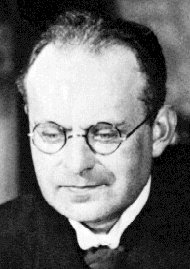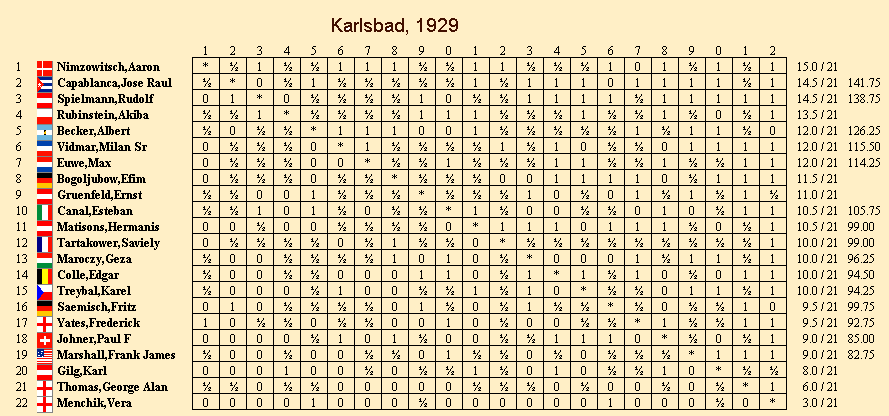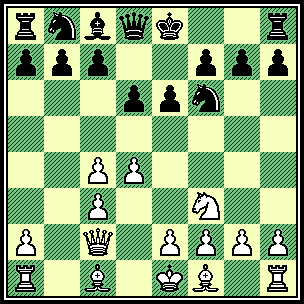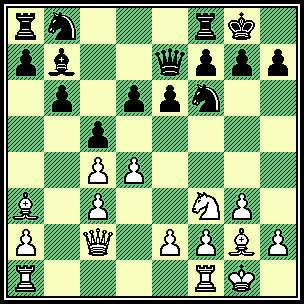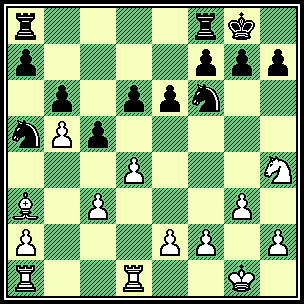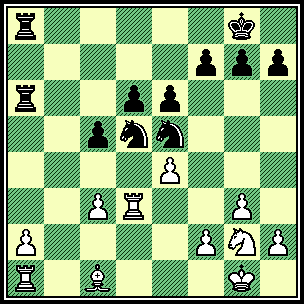All
the |
(Navigation bar
directly below.)
*******
© A.J. Goldsby, 2015.
(All rights reserved.)
****************
Click HERE
to see my
Chess Items.
****************
****************
Buy a book
from Amazon.com
(And help me out as well!)
****************
Click HERE
...
to see a list of the businesses that help to sponsor all of
my chess efforts.
The Father of the Revolution, (Game #1).
Aaron Nimzowitsch
|
|
Born in Riga (Lettland) in 1886, after many travels, Nimzovich, (as he is more commonly known); eventually settled in Denmark, where he died in 1935.
Nimzovich probably learnt chess at a young age, (8 - or younger?); having been born a Latvian Jew, but he did not take the game seriously until he was in college. Instead of studying university-level mathematics, Nimzovich devoted all of his time to chess, and began making rapid progress.
He first gained international notice at the Ostend Masters Tournament of 1907, where he shared third place. (He took clear third in Hamburg, 1910.) He improved to second prize at San Sebastian , 1912 – he also won many nice match victories as well. According to a CB 9.0 profile, Nimzovich won about a dozen top-flight tournaments, and during the period of 1925 – 1930, was probably numbered among the two or three best players in the world. (The other two being Capablanca and Alekhine.) Nimzovich never got a chance to play for the title when he was in his prime; Alekhine chose to play Bogo, (Bogolyuboff, or Bogoyubov); two matches instead.
Nimzovich, however, was NOT just another player! Like Rubinstein, he made enormous contributions to the game as well. He was part of the “hyper-modern” movement of the 1920’s and 1930’s in chess. This group began to challenge many of the dogmas of the classical school, and gave many new insights to the game itself. Nimzovich was also an important chess writer; his writings are living works that speak to chess players everywhere – even today. He wrote simply, but with great passion, superb instruction and even a touch of wit. He expounded and explained the new ideas, both Bent Larsen and Tigran Petrosian were said to be deeply affected by Nimzovich’s books. His understanding on pawn play and his clear elucidation of those ideas were revelations – in their day – and are still eye-openers in the post-2000 era.
Perhaps the greatest testament (today) to Aaron Nimzovich is in the opening, where there are many different systems and lines that are named after him. Rejected as too bizarre when it was first played, his “Nimzo-Indian” System is one of the most solid and popular of all the defenses to the QP opening – even today. (World Champions have played one or both sides of this opening, a tribute to its viability and its soundness.) I think that Nimzovich would prefer to be remembered as a strong and original thinker who was quick to challenge the old, orthodox ideas.
Please see my column for Feb, 2006. (This game contains a detailed discussion of the hyper-modern ideas in action.)
The "Oxford Companion To Chess," (2nd Edition, by Hooper and Whyld); has several pages of excellent biographical information on Aaron Nimzovich. (Search Google for this book.)
The excellent book, "Aron Nimzowitsch: A Reappraisal," by GM Raymond Keene is also one of the best books available on the games of this player. (Mine is the hard-back version of this book {with a blue dust jacket} that was published in 1974 by G. Bell and Sons, Ltd. (Reprinted in the USA by David McKay of New York.) ISBN # 0-679-13040-3 (Unfortunately, this book is in descriptive notation, which makes it hard to read ... I have gotten used to algebraic, I even record my games this way now.)
***********
Saturday; March 24th, 2007: See this blog entry on the discussion of Nimzovich's name.
************************************************************************************************
[The Wikipedia entry
for this player.] [The games
of this player.]
[Books
on Nimzovich.]
[Images.]
[Nimzovich's "Chess Metrics" page.]
Note that Nimzovich did not just beat the tail-enders in this tournament, of the "Top Eight" ... he had the best score.
Click
HERE
to see an explanation of the symbols that I use when annotating a chess game.
[Replay this game,
but on a different website. You can also download this game in PGN format.]
Prologue, (to the game - given below):
One of the basic ideas of the whole of the Nimzo-Indian Opening system is to give White a doubled QBP-pawn complex ... and then play the rest of the game trying to fix, (blockade); attack and destroy those pawns. (Especially concentrating on the c4-square.) Back in the 1970's, I played a game that went something like: 1.d4 Nf6; 2.c4 e6; 3.Nc3 Bb4; 4.a3 Bxc3+; 5.bxc3 0-0; 6.Nf3 c5; 7.e3 b6; 8.a4!? d6; 9.Bd3 Ba6; 10.0-0 Re8; 11.Re1 Nc6; 12.e4 e5; 13.d5 Na5; 14.Qe2 h6; 15.g3 Qd7; 16.Kg2 Rac8; 17.Nh4 Kh7; 18.Qa2 Red8; 19.f4 Qe8; 20.fxe5 dxe5; 21.Nf3 Qe7; 22.Kh1 Ne8; 23.Be3 Nd6; 24.Nd2, and Black eventually went on to win. (This is from memory, so I am not 100% sure of the moves ... or even the particular move order. However, I am fairly sure of the first seven or so moves.)
While my play in this game was far from perfect - and I was just a class "C" player when this contest was actually played - I was still very proud of the manner of play as I conducted the flow and harmony of the Black pieces. I also felt that my play was close to the ideal procedure that Nimzovich himself might have used when he played this opening system. This was best demonstrated by Nimzovich's [model] games, and the way that he outlined his approach {to 'his' opening} in his various books. (For example, carefully study the classic volume, "My System.")
Today, this opening has literally hundreds of branches and variations, with many lines and methods of play that may not have been actually anticipated by Nimzovich ... when he first created this opening system. However, I often feel - especially when Black loses - that the second player should go back and study the way that the great master himself handled this line, the game below is nearly a perfect example of the correct way (for Black) to play this opening.
Bear in mind -- while it is easy to criticize this game ... (the one given below), in the post-2000 era -- that the theory of 1929 was considerably less developed than it is today. (Few books, very few magazines, poor communication between countries, no large games db, NO computers, NO Internet!)
I have always felt that Fred Reinfeld - and many others! - had been grossly unfair in their criticisms of this game. When I first went over this highly celebrated encounter, it seemed to me that White had done little wrong, and Nimzovich's victory was achieved by almost supernatural means. I hope that my version of this game will allow you to see this game as I first saw it ... and share the joy and marvel at the technique that Black used to win this game. I also re-analyzed this game from scratch - of course using the computer - so many of the variations and ideas might be new to you.
H. Matisons
(2601) -
A. Nimzowitsch
(2772)
|
|
|
[A.J. Goldsby I]
One of the great games that was played at the dawn of the new "Hyper-Modern" age, White resigns before he loses even a single Pawn.
1.d4,
White opens with the QP, a good move, as the center is staked out and several pieces now have more open lines. (White is commonly given as H. Mattison, Black as A. Nimzovich. I give the names,
{above, at the beginning of the game}; as they are given by ChessBase on-line games db.)
1...Nf6,
Black develops. (Nimzovich was one of the leaders of the "Hyper-Modern revolution," so you should not be surprised that he disdains the classical reply of advancing his QP two squares.)
2.c4,
White claims more space, his c-pawn also attacks the key d5-square.
(The ratings here are those of the "Chess Metrics" website, see his July, 1929 rating
list.)
2...e6;
This move hits d5, and frees Black's KB and the Queen.
(Black could now transpose back to a Queen's Gambit after 3.Nc3, and now 3...d5.)
3.Nc3,
This move hits the center and develops a piece. (It is a common, modern misconception that Matisons - from Lettland,
which is modern day Latvia - was a fish. Nothing could be further from the truth! He won clear first at the small - but strong - 1924 Paris Olympiad. Max Euwe - a future world champion - was tied for 4th through sixth place, 1.5 points behind Matisons. Matisons also won several international events, one example would be
Bromley, 1925. Jeff Sonas [The
CM website.]
shows that Matisons was once ranked as high as # 12 in the world, and had a near 2700 PR in the men's Olympiad at Prague in 1931. See
http://en.wikipedia.org/wiki/Hermanis_Matisons for more details, and the "Chess Games"
website for a few of his better
games.)
3...Bb4;
Nimzovich plays his own system, some of his ideas were openly scorned by the high-level masters of that day. Derision, however, had little impact on Nimzovich ... other than to make him more determined than ever to succeed. (Nimzovich won this
tournament - Karlsbad, 1929 - 1/2 point ahead of Capablanca and Spielmann, who were tied for second and third. This made this tournament
{see the cross-table, above} one of the greatest triumphs of the whole of Nimzovich's long and storied career.)
4.Nf3,
White plays a simple developing move, dozens of GM's have won with 4.Nf3, so it cannot be wrong. (4.e3 would have led to the "Rubinstein System," considered by many masters to be one of White's best systems against the Nimzo-Indian.)
[ One of the time-honored main lines would be:
(>/=) 4.e3
0-0; 5.Bd3 d5; 6.Nf3 c5; 7.0-0 Nc6;
8.a3, "+/=" {Diag?}
with an edge for White.
See the game, G. Kasparov - V. Kramnik; Linares, ESP / 1997.
[ See also MCO-14, page # 539; all columns and relevant notes. ] ]
4...Bxc3+;
('!?')
Nimzovich immediately hands his opponent a set of doubled pawns on the Q-side, the masters of that day did not understand this move, some even labeled it an error. (They believed that Black should wait for White to play a3 before being provoked into this exchange.) However,
Nimzovich's insight into this position far exceeds that of his opponent's.
5.bxc3 d6;
Nimzovich develops in a fashion that was virtually unique at that time. (Reinfeld did the world a large favor by publishing a book of Nimzovich's games. Yet he did the world a huge DIS-service by scarring many of these games with unnecessary question marks. In the end, I don't think that Reinfeld understood hypermodern chess any better than many of the masters of the 1920's and 1930's did.)
6.Qc2,
"+/="
White gets the Queen out and also controls the vital e4-square.
|
|
rnbqk2r/ppp2ppp/3ppn2/8/2PP4/2P2N2/P1Q1PPPP/R1B1KB1R b
Some masters condemned this move, I will only note that it is the first choice of Fritz 9.0 - and many other strong programs as well.
6...Qe7;
Nimzovich violates more of the opening's standard principles, modern convention says that the Queen should be developed last.
(What is Black's plan?)
7.Ba3,
Matisons tries to pressure Black and prepares e5-e5. However, White would have done better to play the simple 7.Bg5, retaining a small (but secure) advantage.
[ >/= 7.Bg5 h6; 8.Bh4 e5; 9.e3, "+/=" ]
7...c5!; (Blockade.)
Black's opening schemata has been revealed, he will block the center with this pawn play, his whole opening has been about preparing this one move.
8.g3, ('!?')
White prepares to fianchetto his KB, however e3 (or e4) were probably better. (White will soon find himself unable to effectively control his c4-square.)
[ >/= 8.e4 e5; 9.Bd3 0-0; 10.0-0, "=" ]
8...b6; ('!')
Black counters with a fianchetto of his own, this is excellent and also strengthens Black's grip on the dark squares, particularly c5. (One of the best books on Nimzovich's career would have to be: "A. Niemzowitsch, A Reappraisal," by GM Raymond Keene. [review]
This volume contains a detailed analysis of many of Nimzovich's games and also a close look at his entire career.)
* * * * * * * * * * * * * * * * * * * * * * * * *
The next couple of moves do not require much comment, both sides continue with their indicated plans of development.
9.Bg2 Bb7; 10.0-0 0-0;
The opening is just about over, it is time to try and evaluate this position. Black is at least equal, all of his pieces can come to really strong squares. Meanwhile, White's QB, which is effectively shut out of the game on a3, is a piece in need of finding an effective diagonal.
|
|
rn3rk1/pb2qppp/1p1ppn2/2p5/2PP4/B1P2NP1/P1Q1PPBP/R4RK1 w
A classical player was unable to really grasp this position ... his pair of Bishops mean little, and his pawns in the center only appear to be strong.
11.Nh4,
('?')
White is feeling the pinch at this point, the tournament book reveals that Matisons took a lot of time over this move. It is a doubtful concept, this piece might be needed on d2 ... so as to help control the c4-square.
[ >/= 11.Rfd1 Be4; 12.Qa4 Nc6; 13.Bc1 h6, "=/+" ]
11...Bxg2;
12.Kxg2?!,
White captures with the King, I am sure that Matisons was thinking about f2-f4 and then f5. Yet this is a pipe dream and is a plan that is not grounded in the reality of the position. (White should have taken with the Knight.)
[
>/= 12.Nxg2
Nc6; 13.Rad1 Na5; 14.Ne3 a6; 15.Qd3
Rfd8; 16.Rb1 Rab8; 17.Rfd1 Qe8, "=/+"
Black is solidly better, ("=/+"); but no forced win is in sight.
]
12...Qb7+!;
This looks like an idle check, but in reality, the light squares are weak, and Nimzovich alertly begins probing them.
13.Kg1,
White sticks with his plan, yet it would have been (a little) better to play the KN back to f3.
[ >/= 13.Nf3 Nc6; ("/+") ]
13...Qa6!;
Black continues with his sustained assault on the light squares, note that developing the QN to d7 would have prevented this excellent lateral maneuver of the
Black Queen.
14.Qb3,
This was forced.
14...Nc6;
Now thanks to the off-side Knight (on h4), White is unable to effectively counter the pressure to his c4-square.
(Now Black threatens ...Na5.)
15.Rfd1 Na5; 16.Qb5[], {Box.}
This was forced, otherwise White loses a Pawn.
[ </= 16.Qa4 Qxc4; 17.Qc2 d5; "-/+" ]
16...Qxb5;
17.cxb5,
Seemingly White can be happy. Black has two Knights, and one of them is offsides, just like White's Knight on h4. Superficially, it would be easy to
surmise that White is better here.
|
|
r4rk1/p4ppp/1p1ppn2/nPp5/3P3N/B1P3P1/P3PP1P/R2R2K1 b
Study this position for just a few minutes and see what you think.
(Note that White has undoubled his Pawn ... and may be
thinking that all of his troubles are behind him.)
17...Nc4!;
This forces the White QB back to its original square ... but at first glance, this does not seem to be a big deal. (Note that White has no way to attack this Knight nor drive it off its current beautiful square.)
18.Bc1 a6!;
Now Black opens a file to the Queen-side, enabling Black's Rooks to quickly enter the fray.
19.bxa6, (forced)
White captures, the best programs confirm that White had no choice in this position.
[ </= 19.Rb1? axb5; 20.Rxb5 Rxa2; 21.Kf1 Nd5; "-/+" ]
19...Rxa6;
What a turn-around from just a few moves earlier. (Suddenly, Nimzovich has all the play.)
20.dxc5 bxc5!;
This is much better than the re-capture with the other Pawn ...
now Black has a unified P-skeleton and the open b-file for the other Rook as well.
21.Ng2 Nd5!;
This hits c3, most of my students (instead) choose to double the Rooks on the a-file.
22.Rd3 Rfa8; 23.e4,
White understandably panics ... it really did not matter, as there is no saving line for Matisons.
[ The computer suggests instead:
(>/=) 23.a3
Nxa3; 24.Ne3 Nxe3; 25.Bxe3 h6; 26.Kg2
Nc4; "-/+"
but White still has lost a Pawn and the box confirms that the position
is indefensible for him. ]
23...Ne5!; "-/+" White Resigns.
Mr. Matisons gives up the struggle, he is about to lose two or three buttons in rapid-fire succession.
(I.e., 24.Rd1, NxP/c3; etc.)
|
|
r5k1/5ppp/r2pp3/2pnn3/4P3/2PR2P1/P4PNP/R1B3K1 w
[ After the moves of:
23...Ne5;
24.exd5 Nxd3; 25.Nf4 Nxf4; 26.Bxf4 e5;
27.Be3 Rxa2; "-/+"
there is no reason at all for White to continue from here.
]
A wonderful game, and a triumph for the new school of thought. As the great Irving Chernev noted, Nimzovich's powerful centralized Knights make a striking impression.
***********************************************************************************************************************
BIBLIOGRAPHY
I have seen this game dozens of times in print, what follows are just two of the books that showcase this particular encounter.
# 1.) "The Golden Dozen," (The twelve greatest chess players of all time.); by Irving Chernev.
HB / Published in 1976 by Oxford University Press. ISBN: # 0-19-217536-X [This
book
- but a paperback version.]
# 2.) << Hypermodern Chess >> ("As developed in the games of its greatest exponent, Aron Nimzovich.")
By Fred Reinfeld. Published in 1948 by David McKay of NY/USA. [A
Dover reprint
of this book.]
***********************************************************************************************************************
Copyright (c) A.J. Goldsby, 2006. All rights reserved.
1 - 0
The Impala Blog Page for this game. More on Nimzovich's opponent in this contest.
The analysis for this page was prepared with the excellent programs, ChessBase 8.0 and ChessBase 9.0.
The HTML was polished with several different tools and programs, (mostly FP) ... the text was checked for spelling with MS Word.
The diagrams were created with the program, Chess Captor 2.25.
******************************************************************************
This page was first uploaded on: Monday; October 9th, 2006. Posted 10/12/2006. Page last edited: Saturday, July 14, 2012 02:16 AM .
[Home] [Site Map] [News page] [Annotated games, # 2] [Best players, Best Games.]
Copyright (©) A.J. Goldsby, 2010. All rights reserved.
